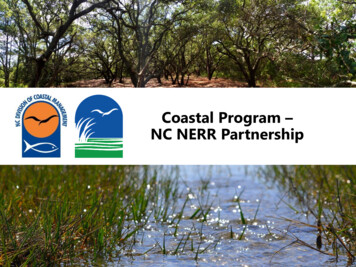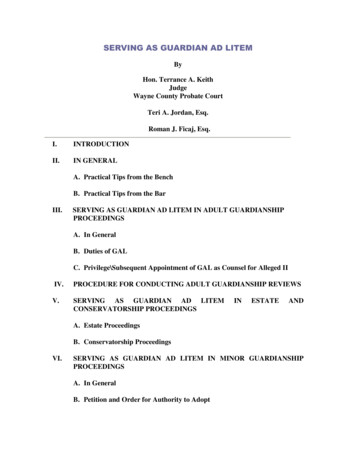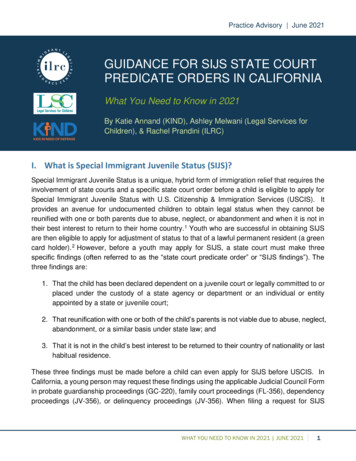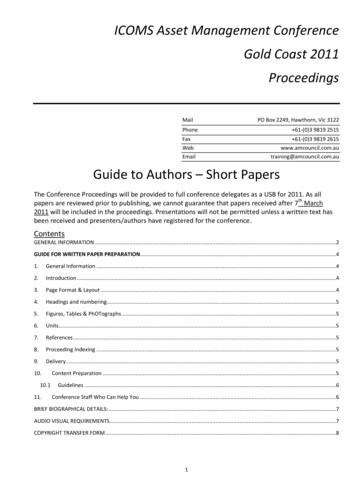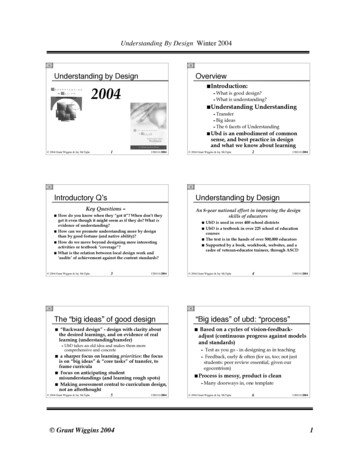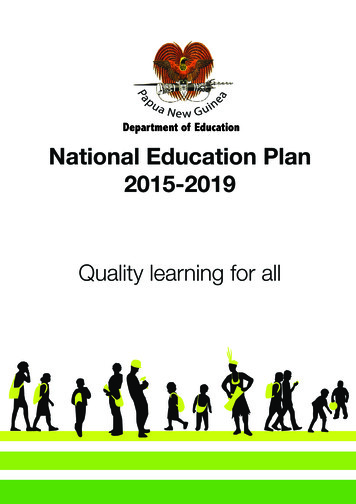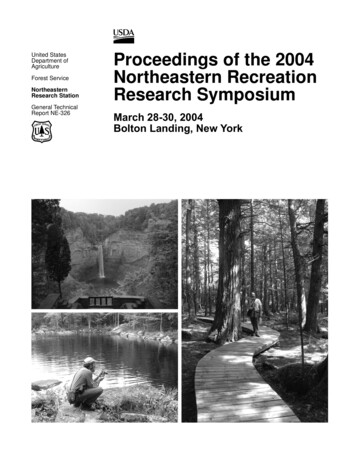
Transcription
United StatesDepartment ofAgricultureForest ServiceNortheasternResearch StationGeneral TechnicalReport NE-326Proceedings of the 2004Northeastern RecreationResearch SymposiumMarch 28-30, 2004Bolton Landing, New York
Northeastern Recreation Research Symposium Policy StatementThe Northeastern Recreation Research Symposium seeks to foster quality information exchangebetween recreation, tourism, and resource managers and researchers throughout the Northeast.The forum provides opportunities for recreation and tourism research managers from differentagencies, state, and government levels, as well as those in the private sector to discuss currentissues, problems, and research applications in the field. Students and all those interested incontinuing education in recreation and tourism management are particularly welcome.NERR 2004 STEERING COMMITTEE:Robert Bristow, Westfield State CollegeKelly Bricker, West Virginia UniversityChad Dawson, SUNY College of Environmental Science and ForestryEllen Drogin Rodgers, George Mason UniversityAlan Graefe, Penn StateAndy Holdnak, University of West FloridaDeb Kerstetter, Penn StateDiane Kuehn, SUNY College of Environmental Science and ForestryWalter Kuentzel, University of VermontBruce Lord, Penn StateTom More, USDA Forest Service - Northeastern Research StationAndrew Mowen, Penn State UniversityJim Murdy, University of New HavenRobert Robertson, University of New HampshireDavid Solan, Mansfield UniversityRudy Shuster, SUNY College of Environmental Science and ForestrySharon Todd, SUNY CortlandGail Vander Stoep, Michigan State UniversityHans Vogelsong, East Carolina UniversityGreg Wright, USDA Forest Service - Green Mountain National ForestCover photos courtesy of Mark and Robin Twery.Note: These proceedings have been prepared using electronic and hard copy supplied by the authors. Whilesome editing has been done, the authors are responsible for the content and the accuracy of their papers.The use of trade, firm, or corporation names in this publication is for the information and convenience of thereader. Such use does not constitute an official endorsement or approval by the U.S. Department of Agricultureor the Forest Service of any product or service to the exclusion of others that may be suitable.
Proceedings of the 2004 Northeastern Recreation Research SymposiumMarch 31 – April 2, 2004On Lake George in Bolton Landing, New YorkCompiled and Edited by:Kelly BrickerSarah J. MillingtonWest Virginia UniversitySponsors:Adirondack MountainClubVenture PublishingUSDA Forest Service, Northeastern Research StationPublished by:USDA Forest Service, Northeastern Research Station
ContentsKEYNOTE ADDRESSA Restorative Definition for Outdoor Recreation . 1William E. HammittFOUNDERS FORUMSocial Change and Post Utilitarian Resource Management:Adaptation or Transformation? . 6Walter KuentzelPLACE ATTACHMENTSpatial Variation in Level of Place Attachment . 14Gerard Kyle, Alan Graefe, Robert ManningCreating Defensible Space in the Wildland-urban Interface: The Role of Basic Beliefsabout Forest and Wildfire Management . 20Alan D. Bright, Randall T. BurtzStress and Coping in the High Peaks Wilderness: An Exploratory Assessment of VisitorExperiences . 29John G. Peden, Rudolph M. SchusterCampers Across the Recreation Opportunity Spectrum: A Comparative Examination . 39Drew A. Cavin, Jenny K. Cavin, Gerard Kyle, James AbsherFlorida Resident’s Familiarity with Korea: Do More Familiar Residents Have MorePositive Images? . 46Jung Eun Kim, Lori Pennington-GreyThe Way the World Should Be: Order, Cleanness, and Serenity in the Experience ofSpecial Places . 52Herbert W. Schroeder“They All Cared about the Forest”: Elementary School Children’s Experiences of theLoss of a Wooded Play Space at a Private School in Upstate New York . 57Clifford Blizard, Rudolph Schuster, Jr.DIVERSE POPULATIONSAn Exploration of the Relationship between Puerto Rican Values and the Perception ofBenefits and Park Use . 66Edwin GómezConstraints to Recreational Fishing: Concepts and Questions to UnderstandUnderrepresented Angling Groups . 70Laura E. Anderson, David K. Loomis, Ronald J. SalzRace, Ethnicity, and Information Use Related to Natural Resource Recreation . 75Sungsoo Kim, Lorraine Nicholas, Gloria Sanders, Myron Floyd, Injae LeeAmerican Indian Gathering and Recreation Uses of National Forests . 81Leo McAvoy, Paul Shirilla, Joseph Flood
TOURISM ECONOMICSHow to Handle High Proportion of Zero Observations in the Cross-section Studies:Application to Nonresidential Wildlife Watching Expenditures . 90Yeong Nain Chi, Guang-Hwa Andy ChangEconomic Impact of the Pictured Rocks National Lakeshore and the Estimation Errors . 98Ya-Yen Sun, Daniel StynesVariations in Economic Multipliers of the Tourism Sector in New Hampshire .102Joshua Wiersma, Doug Morris, Robert RobertsonChallenges of Using Estimations of Economic Impacts for Cultural Tourism .109Gail A. Vander StoepVISITOR MANAGEMENTState Park Trail Conflicts and Resolution Strategies .120Charles M. Nelson, Rebecca Jennings, Jennifer HenschellFactors Affecting Importance Ratings for Private Campground Amenities .126Andrew Holdnak, Ellen Drogin RodgersAssessment of Recreation Impacts on Wilderness Campsites, Mark Twain NationalForest, Missouri . 130Kale Horton, Robert PavlowskyRecreation Use at Diamond Lake, Oregon: Perceptions of Users’ RecreationExperience between 2001 and 2003.139Robert C. Burns, Alan R. Graefe, Sunny Nam KilAlbany Pine Bush Preserve: A Case Study Using Concepts from the Limits ofAcceptable Change Framework .145Victoria E. Gray, Chad DawsonLeave No Trace and National Park Wilderness Areas .152Carol GriffinVisitor Perceptions of Intelligent Transportation Systems in a National Park .158Ginni Dilworth, Scott ShaferEstimating Visitor Use and Distribution in Two Adirondack Wilderness Areas .164Nathan E. Peters, Chad P. DawsonA Case Study Comparison of Visitor Self-reported Travel Routes and GPS RecordedTravel Routes .172Jeffrey C. Hallo, Robert E. Manning, William Valliere, Megha BudrukTOURISM DEVELOPMENTAn Exploratory Study of St. Augustine, FL: Heritage Attraction Types .180Matt Wagenheim, Lori Pennington-Grey, John ConferUnderstanding Angler Preference for Harvest Regulations by Level of SpeciesPreference .185Chi-Ok Oh, Robert B. DittonRegulations on the Environmental Management of Tourism Development in YunnanProvince, China .192Erwei Dong
Perceptions of Haitians Toward Tourism Development in Rural Haiti . 200Alain R. Thermil, Amy L. SheafferExamining the Business Tourist . 209Brandi Nice, Lori Pennington-GreyMyth vs. Fact: An Exploration of Fright Tourism . 215Robert S. Bristow, Mirela NewmanPERCEPTIONS, PREFERENCES, AND ATTITUDESThe Influence of Distance and Visitor Perceptions of Security on PerceivedManagement Problems Among New England Anglers . 224Thomas Wickham, Alan Graefe, Robert C. Burns, Thomas MuellerComparative Analysis of Visitor Attitudes and Preferences in Three AdirondackManagement Areas . 231Nancy A. Connelly, Chad P. Dawson, Tommy L. BrownTRENDSNortheast’s Recreation Trends and Markets – A New Data Source . 242Rodney B. WarnickTrends in Participation Rates for Wildlife-Associated Recreation by Race/Ethnicityand Gender: 1980-2001. 251Allan Marsinko, John DwyerNew York’s Great Lakes Charter Boat Fishing Industry: 1975-2002 . 256Diane M. Kuehn, Frank R. Lichtkoppler, Charles PistisEmerging Trends in Park and Protected Area Management: A Critical Analysis of theEastern James Bay Region of Quebec, Canada . 263Daniel LavenVISITOR CHOICE AND RESOURCE ATTRIBUTESThe Impact of Negative Environmental Factors on Recreation Choice Behavior . 272David B. KlenoskyExamining the Structure of the Leisure Involvement/Place Bonding Relationship inThree Sumter National Forest Camping Areas . 281Jenny K. Cavin, Drew A. Cavin, Gerard Kyle, James AbsherStream Attributes for Selecting Substitutable Fishing Resources . 289William E. Hammitt, Erik A. Backlund, Robert D. BixlerExplaining Patterns of Choice Among Outdoor Recreation Sites in Metropolitan Areas . 295John F. Dwyer, David B. Klenosky, Cherie L. LeBlancNORMS AND CARRYING CAPACITYDetermining Acceptable Carrying Capacities for Recreation Use as Identified by KeyStakeholders: A Focus Group Process . 304Rob Porter, Michael A. TarrantAn Ipsative Approach to Norm Crystallization . 310James D. Absher, Jerry J. Vaske
SPECIALIZATION AND PARTICIPANT DEVELOPMENTConstraints to Recreational Fishing: Concepts and Questions to UnderstandUnderrepresented Angling Groups . 316Laura E. Anderson, David K. Loomis, Ronald J. SalzUnderstanding Volunteers’ Motivations . 321Katerina Papadakis, Tonya Griffin, Joel FraterValidating Level of Development through Self-assessments of Adventure Recreationists . 327Sharon L. Todd, Anderson B. Young, Lynn Anderson, Dale AndersonPLANNING AND ADMINISTRATIONUsing the Case Study Method to Explore the Potentials and Pitfalls of Fast Ferry inRochester, NY . 336Joel Frater, Arthur GrahamAnatomy of a Heritage Area Start-up: The Appalachian Forest Heritage Area . 343Steven Selin, Susan Martin, Angela Gernert, David McGillSurvey Techniques for Assessing Public Preferences for Alternate SilviculturalTreatments in the Adirondacks . 350Donald F. Dennis, Mark J. Twery, Michael A. Rechlin, Bruce HansenThe Influence of Water Clarity on Recreation and Home Purchasing Decisions onNew Hampshire Lakes . 354Kevin Scribner, John Halstead, Ryan McCarthy, Julie GibbsSUBMITTED PAPERS FROM THE POSTER SESSIONThe Illinois Department of Natural Resources “Becoming An Outdoors-Woman (B.O.W.)” Program: Factors Related to Outdoor Recreation Participation . 362Katharine A. PawelkoMonitoring the Impacts of Visitors to Shorebird Populations in the NPS Coastal andBarrier Island Network Areas . 373Christopher A. Monz, Erica A. Young, Yu-Fai LeungCognitive Mapping: An Application for Trail Management . 378Samuel V. Lankford, Kathy Scholl, Robert Pfister, Jill Lankford, Albert WilliamsA Comparison of the Perceived Relative Importance of Council on AccreditationCurriculum Standards between Academicians and Public Park and RecreationAdministrators . 385Eric L. LongsdorfIdentifying Issues with Local Recreation Providers for the 2004-2009 Indiana Scorp . 390Amy L. Sheaffer, Yi-Ling SungThe Relationships among Leisure Resourcefulness and Recreation Specialization,among a Sample of Senior Adults . 397Jerry L. RicciardoResidents’ Attitude Toward Tourist Market Segments and Tourism Development inValdez, Alaska: A Comparison of Residents’ Perceptions of Tourist Impacts on theEconomy and Quality of Life . 404Christine A. Vogt, Soo Hyun Jun
Examining Specialization for a Fishing Subactivity: Is Activity and Place SpecializationBetter Understood at the Activity or Subactivity Level? . 412Aurora Moldovanyi, Chad Pierskalla, Michael SchuettPAPERS PRESENTED AT THE 2003 CONFERENCEWho Participates in Fall-color Touring on Pleasure Trips? . 418Seunghyun Kim, Chang HuhAuthor Index . 422
A RESTORATIVE DEFINITION FOR OUTDOOR RECREATIONWilliam E. Hammitt1Department of Parks, Recreation, and TourismManagementClemson UniversityClemson, SC 29634AbstractThis paper challenges the traditional “re-create”definition of recreation, offering in its place a restorativeorientation based on Attention Restoration Theory. Itwill be argued and demonstrated that we are not in thebusiness of “re-creating” something that has been lost,but rather, in the business of restoring people’s mentalwell-being that has been fatigued. Outdoor recreationresearchers and managers should be concerned withrestorative environments and experiences, not the “recreating” of lost human properties and benefits. Thepaper begins with a demonstration to illustrate thedifference between restoration and re-creation, followswith a conceptual presentation of Attention RestorationTheory and the components of restorative environments,and ends with some psychophysiological evidence fromnatural and outdoor recreation environments thatsupport a restoration approach to recreation resourcemanagement. The conclusion proposes that we arerestoration recreationists, with a philosophical role notmuch different from restoration ecologists, restorationarchitects, and restorative psychologists.occur? Not in the practical sense, but in a theoreticalsense. What are the psychological and physiologicalqualities that underpin the creation anew duringrecreation? What is the theoretical foundation and/orprocess by which the recreate of recreation occurs?The basic purpose and premise of this paper is tochallenge you by saying “We (outdoor recreationists)are NOT in the recreation business, but rather, therestoration business.” In most situations we are notinvolved in the process of creating anew something thatis lost within humans, but rather, restoring somethingwithin them that has been weakened or fatigued. Thisrestorative definition of outdoor recreation will bedeveloped by addressing four major themes entitled:The ARGUMENT, DEMONSTRATION, ART, andEVIDENCE.2.0 The ArgumentKelly, (1996) states that“recreation stems from the Latin recreatio, whichrefers to restoration or recovery. The term impliesthe re-creation of energy or the restoration of abilityto function. Recreation contains the concept ofrestoration of wholeness of mind, spirit, and body. Itpresupposes some other activity that depletes, tires,or deteriorates that wholeness” (p. 25).1.0 IntroductionThe term, Recreation, is an extension of the basic word,Recreate. Recreate, in turn, infers “to create anew”(Guralnik, 1974, p. 1188). Recreation, in its mostgeneric sense, means to re-create something anew inpeople, something that has been lost during people’snon-leisure time. This re-create definition of recreationhas never been satisfactory to me. The question arises,recreate what? What is lost during non-leisure time thatis recreated during our leisure time? And, how does it1Paperbased on keynote address at NERR luncheon, 29March, 2004. The author greatly acknowledges Rachel andStephen Kaplan for the psychological and theoretical material,especially Attention Restoration Theory, that serve as the basisof this paper and the presentation delivered at NERR. Theideas are theirs; I have only adapted them to the definition foroutdoor recreation. I wish to acknowledge Chun-Yen Chang forthe yet to be published information on the psychophysiologicalresponse of humans to outdoor-restorative environments.There are several key words in Kelly’s statement thatsupport the argument for a RESTORE rather thanRECREATE, definition of outdoor recreation. Arestorative definition for outdoor recreation arguesthat recovery is involved, where an ability to function isrestored, involving the mind and body, and presupposessome other process that leads to tiring or deteriorationwithin humans that prevents functioning as desired.Unfortunately, Kelly does not elaborate to provide apsychological and theoretical foundation for how thetiring or deterioration occurs, nor how the restorativeprocess occurs involving the mind and body. Butfortunately for us, Kaplan (1995) in his elaborationsof Attention Restorative Theory (ART) and restorativeenvironments/experiences, does provide a psychologicaland theoretical explanation for the deterioration andrecovery processes involved.Proceedings of the 2004 Northeastern Recreation Research SymposiumGTR-NE-3261
Attention Restoration Theory will be discussed in themethree, The ART, of this paper but be it suffice to sayhere that based on Kelly’s (1996) definition of recreationand Kaplan’s (1995) theory of restoration, that it is thepremise in this paper that outdoor recreation does notre-create something that is lost in humans, but rather, itrestores people’s minds that are fatigued. It is wholenessof the mind in terms of recovery from mental fatigue thatrestorative recreation is concerned. Outdoor recreationresearchers and managers should be (1) concerned withrestorative environments and experiences, NOT (2) recreating of lost human properties and benefits.3.0 The DemonstrationTo demonstrate the difference between the processes ofrestoring and recreating, the function of a pencil will beused. A wooden pencil, when sharpened, fully functionsto aid in the writing of words on a piece of paper. Butshould one write for an extensive period of time, wearingthe lead down until it no longer extends from the end ofthe pencil, the pencil can no longer function as when inits original state. Now, the worn-down pencil can be easilyrestored to its original functioning condition by simplysharpening the pencil again. In this scenario, the pencilwas not recreated, it was simply restored. However, if onewere to take a hammer and smash the pencil, both woodand lead, into splinters and dust, the pencil would need tobe recreated anew before it could function in its originalstate as a writing device.I would argue that in recreation we seldom are involvedwith the process of creating anew something that has beendestroyed and lost, rather we are involved in the recoveryand restoration of a worn-out, fatigue condition to awholesome functioning condition again. Granted, thereare exceptions, such as when a person loses their abilityto function due to injury or sickness and a recreationtherapist is required to help the person learn anew a lostskill or function. But seldom is outdoor recreation mostconcerned and involved with recreation therapy as aprofession.4.0 The ARTThe psychological and theoretical basis behind a restorativedefinition for outdoor recreation is Attention RestorationTheory (Kaplan 1995; Kaplan & Kaplan,1989, 1998).ART provides an explanation for both the fatigue andrecovery aspects of the proposed restorative definition ofrecreation (Kelly,1996; Ulrich et al. 1991).24.1 AttentionThe Attention component of ART concerns twotypes of mental focus or attention states utilized byhumans while processing information and functioningin various environmental settings. The first type ofattention is Involuntary, which requires little effort onthe part of humans in terms of keeping focused onthe environmental information to be processed. It isemployed when the stimuli, both in terms of content andprocess, are interesting, involving, and automatically holdour mental alertness and focus. As a result, involuntaryattention is a pleasurable mode of environmentalinformation processing and functioning, and therefore,comes at no cost to humans. Unfortunately, not allenvironmental stimuli are interesting and involvingin terms of information processing and functioningrequirements. In fact, the majority of our everydayexistence may find us in environmental settings where thestimuli we must deal with are not the most interestingand involving, yet must be processed and acted upon.In these situations humans must call upon Directedattention. Directed attention involves a forced andburdensome form of focused attention that requiresgreat effort to remain with the information and taskfunctioning at hand. The stimuli that must be dealt withmay be mentally demanding, and of little interest interms of desired mental involvement.While humans seem to be quite efficient at using directedattention, it comes at a mental fatiguing cost and canbe employed efficiently for only so long of a period. Asthe mind (and perhaps body) fatigues from the forcedattention required, the mind often wanders to moreappealing stimuli; thereby decreasing the efficiency ofdirected attention. When this occurs, a recovery periodis necessary, where humans can recover from mentalfatigue and restore the ability to once again use directedattention when called upon.4.2 RestorationThe restoration process involves recovery from thecost and pain of directed attention and mental fatigue.Kaplan (1995) has theorized that the restoration processinvolves the recovery of a worn-out inhibitor controlmechanism that is employed by humans during directedattention to ward-off or inhibit more appealing stimulifrom dominating our attention. The means by whichthe inhibitor control mechanism is restored is to not useit; to use no-cost involuntary attention instead of theProceedings of the 2004 Northeastern Recreation Research SymposiumGTR-NE-326
costly directed attention. How is this done? By seekingenvironmental settings where the dominant form ofinformation processing and functioning is involuntaryattention. Kaplan identifies such environments andexperiences as restorative. Restorative environmentsand experiences provide for states of INVOLUNTARYattention, where the inhibitor control can recover andwe restore the ability to again use DIRECTED attentionwhen needed.4.3 The Restorative EnvironmentA restorative definition for outdoor recreation dependsentirely upon the availability of restorative environments,of which it is argued that most outdoor recreationenvironments qualify. However, this qualification isnot automatic and does not lack a theoretical basis ofwhat psychological components are necessary for anenvironment to have restorative qualities. Kaplan et al.(1998) postulate that four psychological componentsmust all be present for an environment to be restorative:Being Away, Extent, Fascination, and Compatibility.Since the restorative definition of outdoor recreationdepends on restorative environments, and restorativeenvironments depend on the four components, thecomponents will be briefly discussed (see Kaplan 1995,and Kaplan et al. 1998 for a detailed discussion).4.3.1 Being AwayRestorative environments must offer the opportunity andqualities to be in a different geographical and/or physicallocation that is removed from the everyday routines andpurposes-tasks of one’s life. It is not restorative to just beaway to a different environment if everyday routines (i.e.work) and tasks accompany you. Also, as Kaplan stresses,where one is being away to is every bit as importantas to where one is being away from. The Being Awaycomponent is not the same as escape or even temporaryescape, for the environment one is going to and itsqualities are of utmost importance to the restorationprocess.4.3.2 ExtentBeing away to another environment is not sufficientfor restoration, for the scope of the other environmentmust be considered. Restorative environments have tooffer elements of being away to new worlds of mentalexploration. The component of extent refers to otherworlds of environmental information to processand function within. The everyday environment wecommonly function within can become quite familiarand limited in scope of new information to process, orcan become quite demanding in terms of uninterestinginformation to process, thus offering few new worlds toexplore. Outdoor environments contain many elementsof extent, providing “other” settings and worlds ofinformation that are extensive in scope yet fascinatingto explore. And, as pointed out by Kaplan (1995), theseenvironments need not be of wilderness area dimensions,for even small environments (i.e., Japanese gardensor vest-pocket parks) can provide the component ofexploration and extent.4.3.3 FascinationEnvironmental stimuli and information that arefascinating, that call forth involuntary attention andhold it, rank high on the qualities of restorativeness.Fascination refers to just not novel content and excitingprocesses within the environments (i.e., hard fascination),but also to elements of soft fascination, such as waterflow, sunsets, snow fall, and the whistling wind.Movement need not always be involved either, for thestructure and form of mountain ranges can occupy ourattention for intense periods of time.4.3.4 CompatibilityCompatibility concerns the element of agreement orfit between how one wants to function, both mentallyand physically, within an environment and how thatenvironment affords the opportunity to function asdesired. It refers to the environmental fit between humanintentions and environmental affordances. Environmentsthat demonstrate a great deal of congruity betweenindividual inclinations, environmental patterns, and theactions required by the environment, have restorativeproperties.4.3.5 Restorative ExperienceEnvironments then, of which outdoor recreationenvironments can be an example, are restorative if theycontain all four of the psychological components ofbeing away, extent, fascination, and compatibility. Theyare restorative in the sense that the four componentspromote the use of involuntary attention, which inturn promotes the recovery from directed attentionand mental fatigue, resulting in restorative experiencesfor humans. Restorative experiences occur whenenvironmental stimuli are fascinating, compatible, andallow being away to another world, where directedProceedings of the 2004 Northeastern Recreation Research SymposiumGTR-NE-3263
attention does not have to be used. In these situations thepain and fatigue of directed attention can recover.5.0 The EvidenceIs there empirical support for ART and therestorativeness of certain environments and associatedexperiences? Two recent special issues on “RestorativeEnvironments” in the Journal of Environmental Psychology(2003) and Environment and Behavior (2001) addressthis question, to which the interested reader is referred.Many of the 13 articles contain data collected usingthe Perceived Restorativeness Scale (PRS) developed byHartig and colleagues (Hartig et al. 1997). The PRS, aswell as other data collection methodologies, are supplyingan accumulating body of support for the theory ofrestorative environments. In addition to the psychologicalevidence produced by the use of the PRS, some authorshave produced physiological evidence that suggestscertain environments contain recovery and restorativequalities (Ulrich et al. 1991).Recent work yet to be published, by C.Y. Chang andcolleagues in Taiwan, provide psychophysiologicalsupport for outdoor recreation and restorativeenvironments. Twelve images of outdoor environmentsselected to represent the four components of restorativeenvironments, were viewed by 110 laboratory subjects.Psychological response (using the 23 item PRS)and physiological response (recording brain waveactivity, muscle tension, and blood volume pulse)were measured for each of the hypothetical restorativeenvironments. Results of the two methodologies lendpositive and similar support for the restorativeness of theenvironmental images.6.0 Summary and ConclusionsThe purpose of this paper was to present a restorativedefinition fo
Alan Graefe, Penn State Andy Holdnak, University of West Florida Deb Kerstetter, Penn State Diane Kuehn, SUNY College of Environmental Science and Forestry Walter Kuentzel, University of Vermont Bruce Lord, Penn State Tom More, USDA Forest Service - Northeastern Research Station Andrew Mowen, Penn State University Jim Murdy, University of New Haven




